

Home
About Us
Allotments
Garden Equipment
Seed Suppliers
Manure Problems
Children's Pages
GLA Blog
Weather Blog
School Veg Patch
Useful Links
Growing Potatoes
** This website is not a shop and doesn’t sell anything! **
Be aware that any external links may contain cookies and you should refer to the particular website's cookie policy
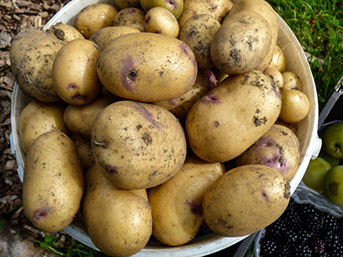 Having plenty of space we grow lots of varieties of potatoes and usually manage to store enough to almost see us through the year. We grow a few different varieties with the idea that whatever weather conditions prevail at least some of the varieties will do well. This has worked for us most years. The exception was during the very hot and dry summer of 2018.
Having plenty of space we grow lots of varieties of potatoes and usually manage to store enough to almost see us through the year. We grow a few different varieties with the idea that whatever weather conditions prevail at least some of the varieties will do well. This has worked for us most years. The exception was during the very hot and dry summer of 2018.
Seed potatoes are categorised into First Earlies, Second Earlies, Early Maincrop and Late Maincrop. These categories refer to the time it takes for the potato crop to reach maturity. The earlier to mature generally suffer less from pests and disease problems. We don’t grow any late maincrop potatoes as we want the plants to have grown a decent crop before the onset of any potato blight. In this way even if the tops do succumb to blight we usually manage a decent harvest. We also want to get our potatoes up and stored early to cut down on any slug problems.
 Different potato varieties have different characteristics that make them more suitable for cooking in a certain way so having a range of varieties mean that you can select a good baking variety, a good mashing variety etc.
Different potato varieties have different characteristics that make them more suitable for cooking in a certain way so having a range of varieties mean that you can select a good baking variety, a good mashing variety etc.
Potatoes are also classed as floury or waxy. Waxy potatoes are low in starch and have a higher water content. They hold their shape when cooked and make good salad potatoes. Floury potatoes are drier and high in starch. They tend to break down in cooking and become fluffy so are good for mashing and baking. Some potatoes are all rounders and perform well however they are cooked. We’ve found that waxy potatoes tend to suffer less from slug damage.
Seed Potatoes
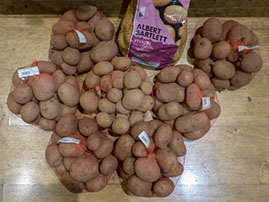
The term seed potatoes can be confusing. Seed potatoes are not seeds, they are potatoes specially grown to give you the best chance of a healthy crop. You must also ensure that you buy certified disease free seed potatoes. Don't be tempted to plant potatoes bought for the kitchen use as these will usually give disappointing results. The potatoes may even fail to sprout as they are sometimes treated to prevent them growing. Seed potatoes are generally sold in net bags.
Choosing varieties to grow
It’s difficult to recommend potato varieties as taste is very subjective. Also the taste and performance of varieties vary depending on the soil they are being grown in and weather conditions.
There always seems to be so much to take into consideration when choosing seed potatoes.
- When do the potatoes mature?
- Are they resistant to particular pests and diseases?
- If you wish to grow in a container which varieties are suitable for container growing?
- How do you cook your potatoes?
If you garden on an allotment ask other gardeners on the site which potatoes perform well.
Most suppliers of seed potatoes will describe the varieties but be aware that they want to sell to you and will obviously describe the potatoes in the best light.
Other sources of information are:
The Potato Council website has lots of information about potatoes including understanding terms such as earlies or maincrop, a brief history of the potato and recipe ideas.
The Potato Variety Database can be a good source of information but is better for finding information about a particular variety that you are considering growing.
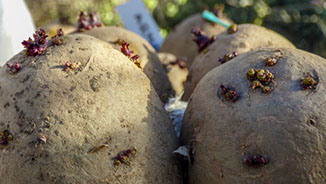 Growing Potatoes
Growing Potatoes
Many gardeners prefer to chit their seed potatoes before planting. If like us your potatoes usually are bought or arrive in late winter or early spring then you have no real option other than to chit them.

To chit, the seed potatoes are placed in a light, cool, frost free location. They then produce short stumpy shoots which some people believe gets the potatoes off to a good start. Whether it does or not no harm is done by chitting.
We leave our seed potatoes to chit in our greenhouse and cover them with layers of fleece if frost is forecast.
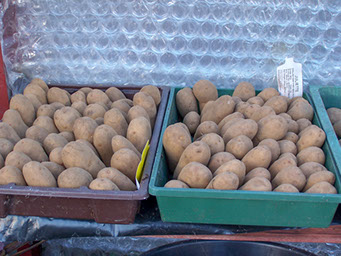
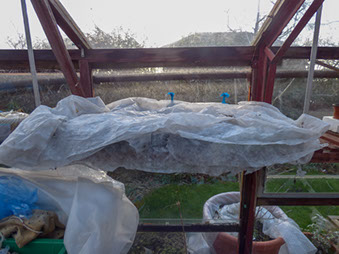
Planting seed potatoes
Some people will dig a deep trench into which to plant their seed potatoes but we prefer an easier method using a trowel (read about it here). We haven’t found that it affects the crop and certainly means that we get our potatoes planted quicker and suffer less aches and pains
Earthing up
As the potato tops grow they need to be earthed up - this means that you must drag earth up from the sides of where the seed potatoes are planted to create a mound. This prevents any potatoes growing near the surface from becoming green. We use a draw hoe for this job.
Growing under weed control fabric
For a few years no we have been planting seed potatoes through holes in weed control fabric, (see here). Using this method there is no need to earth up.
Growing potatoes in containers
As well as growing potatoes in the ground we also grow some in hessian planting bags. These are started off in the greenhouse and moved outside when the greenhouse space is needed for tomatoes. This gives us an earlier crop. Growing potatoes in containers is a good option if you have little space and just want to grow a crop of early new potatoes. For more information about growing potatoes in containers see here. The potatoes can be planted on large plant pots ofr your can buy purpose made planters.
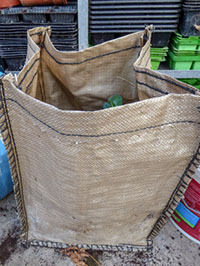
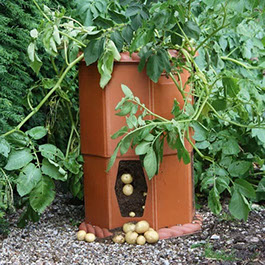
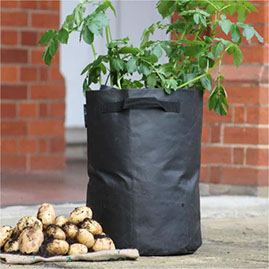
Storing potatoes
We store our potatoes in stacking boxes that we pick up free at the supermarket or in brown paper sacks sold specifically for this purpose. You can also store potatoes in hessian sacks. Don’t store in plastic and make sure that any light is excluded as light will make the potatoes turn green.
Potatoes need to be stored in a frost free place we use our garage. If potatoes are frosted the starch turns to sugar and the potatoes develop a sweet flavour. Don’t store any damaged potatoes as these can spoil your other potatoes. If the damage isn’t severe use these potatoes first cutting off any damaged parts.
Also bear in mind that stored potatoes are very attractive to hungry mice.
I’ve gathered together some links from companies offering gardening products for sale. I have no connection to the suppliers and therefore cannot be held responsible for any changes in items available or any issues that may arise when making a purchase.
Some companies give me a small commission on sales that are generated from this website which helps me to maintain this and sister websites but this in no way means that I am recommending purchases from a particular company.
Our Plot at Green Lane Allotments Blog | A Gardener's Weather Diary | School Vegetable Patch Website
© Our Plot on Green Lane Allotments - Please email me if you wish to use any of this site's content